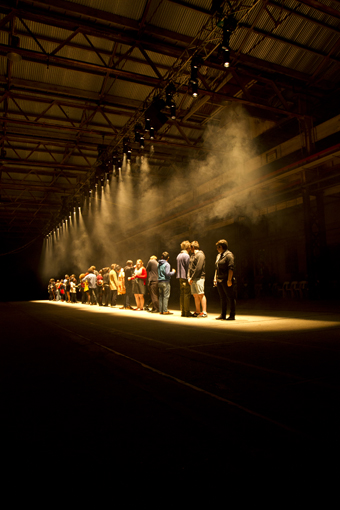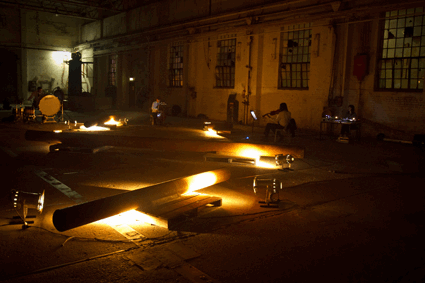 |
Marina Rosenfeld's Teenage Lontano, THNMF 2011 photo © Brad Serls |
The huge industrial space was impressively illuminated with stage lighting for maximum impact, the rig’s installation a feat in itself—a clear embodiment of the effort that has gone into realising these works. Visibility was minimal which only served to add atmosphere to the music.
The evening began with Teenage Lontano. As the audience entered the vast warehouse a teenage choir stood motionless and expressionless in the thin strip of light that cut directly through the performance space. Teenage Lontano is halfway between a ‘cover’ and an interpretation of Gyorgy Ligeti’s choral work Lontano. While Rosenfeld’s composition keeps the choral sound mass as its central sonic characteristic, the addition of pointillist synth sounds curiously obscures the foreground and background of the music. Synthetic and vocal sounds are fused, with changes in either highlighting unique musical characteristics.
The most visually engaging aspect of the work is the rotating speaker suspended above the choir spinning at 33 revolutions per minute, the same as a gramophone record. While the speaker was smaller than expected, it remained something of an engineering feat (on all accounts), adding a Doppler effect to the synthetic sounds also emitting from other speakers during the performance.
The audience was encouraged to wander to experience the work from multiple locations—only a few individuals took advantage of this option. This was a shame, because as you moved past the choir different parts of the sound were highlighted, revealing the intricacies of the work’s functioning in the space. Performers were cued from synchronised iPods, which, in the context of the eerie siren calls, emergency whistles and the tense harmonies of the voices, added an undertone of cultural assimilation to the work making it all the more unsettling.
 |
Decibel performing Marina Rosenfeld’s Cannons, THNMF 2011 photo © Brad Serls |
Once again the audience was encouraged to wander around the space, which many did this time, experiencing the way the piece utilised the unique characteristics of the space. Sitting close to the ensemble, individual details and their direct connection to the musicians are apparent but the listener may have the sensation that they are unable to understand these sounds in the larger context of the work, thanks in particular to the directionality of the cannons. Further away from the ensemble more sonic details become apparent and the separate nature of the sounds slowly collapses into one huge combined sound object, aided by the absence of visual association between sound and performer and their location in the space. Truly a unique experience—no two people hear the performance in the same way.
Teenage Lontano and Cannons rounded out perfectly Marina Rosenfeld’s contribution to the Totally Huge New Music Festival. These works demonstrate different yet connected elements of Rosenfeld’s music exploring the role of projection of sound in space. As such, the performances offered a very special experience of sound sculpture in composition.
Totally Huge New Music Festival 2011: Marina Rosenfeld and Decibel, Teenage Lontano and Cannons, composer Marina Rosenfeld, Decibel artistic director Cat Hope, choir coordinator Laura Lowther, performers Decibel (Stuart James, Tristan Parr, Aaron Wyatt), Teenage Lontano choir members, cannon construction supervision Karlos Ockleford, Michael Bradshaw, production support Jeremy Pownall; supported by Tura New Music, Midland Railway Workshops; Sept 24; www.tura.com.au/totally-huge-music-festival/about
Sam Gillies, a composer and sound artist residing in Perth, is currently in the final year of a Bachelor of Composition and Music Technology degree at WAAPA [Western Australian Academy of Performing Arts]. Sam’s compositional focus revolves around the use of laptop processing to manipulate and add complexity to acoustic instruments, while also actively composing works for installation, film, dance and theatre. He is one of three presenters on public radio RTRFM’s experimental music program, Difficult Listening.
RealTime issue #106 Dec-Jan 2011 pg. 39
© Sam Gillies; for permission to reproduce apply to [email protected]








 back
back